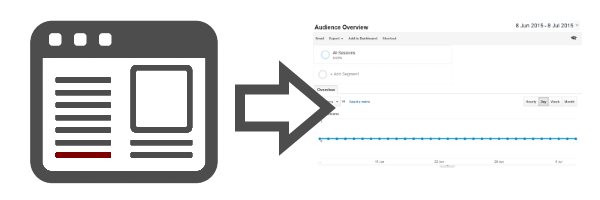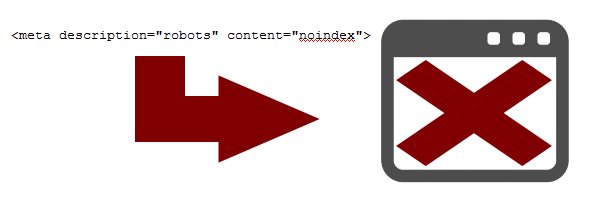When building a site, webmasters often get carried away with the design, content or rankings, and forget SEO best practices that will keep the integrity of their site safe. With so many algorithm changes and Google updates, you definitely don't want to invest time and money into building a good-looking site that fails to even show up in search engine results.
If you are serious about building a site that stands the test of time, make sure you avoid making these five common yet terrible SEO mistakes. Or your site will be eaten up by the next Google update.
Thin content
If you're still creating content solely for keyword rankings, you're doing it wrong. Thin low-quality content won't help you rank higher and won't serve your visitors either since they won't find any value in it.
If you're not familiar with thin content, here are a few examples from Google:
- Automatically generated content
- Thin affiliate pages
- Content from other sources like scraped content or low-quality guest blog posts
- Doorway pages
So, take a closer look at your content and ask yourself the following questions when trying to determine whether your site's content is a little on the thin side:
- Is the content relevant to what users are searching for? Does it offer a useful answer their question?
- Does it match the promise your made in your meta title and description, or are you leaving users disappointed when they land on your site because they can't find what they were expecting to find?
- Is there too little content on a page? A page that consists of only 100 words cannot possibly explain what a product does and how it works, can it?
- Is your content unique, or have you scraped a product description from elsewhere?
Google wants to display content in its search results that people find useful, informative or interesting. So, take a close look at your website content and ask yourself if anyone would really love it or find it useful. Be honest! If not, remove it or combine it with other content to create new content that's valuable.
Find out more about what Google sees as thin content and then learn from Google's Amit Singhal about what counts as a high quality website.
Duplicate content
We're referring to duplicate content within your own site, and not scraping content from other websites. While this is known to be detrimental to SEO, it often happens on large sites or e-commerce sites that have pages covering the same or similar sets of products.
Here are four common reasons that can cause duplicate content issues:
- Misunderstanding the concept of a URL. Each article in a database can be retrieved through several URLs. While developers might see the ID that an article has in the database as the unique identifier for that article, for search engines it's the URL that's the unique identifier to a piece of content.
- URL parameters used for tracking visitors. When you add a parameter to a URL, for example to change the sorting on a set of products or to track where people came from – the URL doesn't actually change the content of that page. However, it does cause duplicate content.
- Order of parameters. If you're using a CMS that creates URLs like /?id=1&cat=2, where 'ID' refers to the article and 'cat' to the category, search engines won't see the URL /?cat=2&id=1 as the same page, but as a different page. This obviously causes duplicate content issues.
- WWW vs non-WWW. When both versions of your site are accessible, search engines might get it wrong and assume those are two different sites with the same content.
Now, having several pages with the same content (this also includes meta titles and descriptions) presents a search engine with a number of questions and issues, such as:
- Which page should I show for this search query?
- Which page should I include/ exclude from my indices?
- Which page should I direct the traffic and link juice to? Or should I just split it across the different pages?
Why would you want your pages to compete against each other? You already have competitors for that. In many cases, an effective way to deal with duplicate content is to set up a 301 redirect from the "duplicate" pages to the original content page. When you do this, search engines will no longer see different pages, but only one. As a result, you're helping your main page rank higher in search engines. Find out more about 301 redirects and how to properly implement them.
You can also fix parameter duplication and eliminate self-created duplicate content in the index with the use of canonical tags. The canonical URL tag attribute is similar to a 301 redirect from an SEO perspective. It basically tells search engines to consider multiple pages as one. However, while a 301 redirects all traffic – human visitors and bots – to a new page, the rel="canonical" tag is just for search engines, meaning it does not redirect visitors to a new URL. Learn more about canonical tags and when to use them.
3. Incorrect Google Analytics implementation
Google Analytics (GA) is a vital tool that can help you track and analyse your site traffic, see where your visitors come from, how they navigate through your site and other interesting information about their behaviour on your site. But you can't get access to all this awesome data if you don't implement GA properly.
Are you making these common mistakes when setting up Google Analytics?
- Not adding the tracking code on every page on your site. No matter how large your site is, you need to add the analytics code to every single page on your page, otherwise GA won't be able to track it.
- Not using sub-domain tracking. If your site is organised into multiple sub-domains like running.example-sportshoes.co.uk, sale.example-sportshoes.co.uk, walking.example-sportshoes.co.uk, you'll need to do some customisation to the tracking code in order to correctly track visitors.
- Tracking internal traffic. If you want to get accurate information on your traffic and visitor behaviour on your site, make sure to exclude yourself, your employees and anyone working with you. All you need to do is to create some filters that exclude the IP range used by those working with you who you're not interested in tracking.
Making these mistakes can also cause self-referrals to appear in your GA report. Self-referrals are any visits within the referral report that are attributed to your own domain. The reason these are an issue is that the incorrectly attributed visits are masking the true source and value of the traffic.
Fortunately, there's a simple solution to fix this. If you're using analytics.js tracking code, go to Admin > Tracking Info > Referral Exclusion list, and that's where you can add any referrers you want to ignore.
Read more about how to quickly (and correctly) track Google Analytics across multiple domains and a href="https://developers.google.com/analytics/devguides/collection/gajs/gaTrackingSite" target="_blank">how to track multiple domains with ga.js.
4. Having a site that is not crawlable
One of the biggest SEO mistakes you can make is to noindex the dev version of your site while working on it and then forgetting to remove the noindex tag when the site goes live. This noindex exclusion prevents search engines from crawling your site, which can cause your rankings to drop.
So, make sure that your site is always crawlable when it's live. Review the robots.txt file to ensure that you're not blocking robots' access to all important pages and elements on your site. Here are a few things you can do:
- Use a tool like Screaming Frog to see which pages on your site carry a Meta Robots tag.
- See which page elements aren't visible to search engines due to crawling exclusion. You can review this in your Google Webmaster Tools within the Fetch as Googlebot section.
- Review the Robots.txt Tester to analyse possible errors.
5. Missing "alt" tags
Did you know that over 1% of the image requests on a daily basis are now referrals from Google and this percentage is increasing! This shows just how important images are for SEO.
Search engines can't actually "see" the images on your site so they can't tell what they're about. They do however scan for text so make sure you use a relevant ALT tag to associate your images with text, providing a bit more keyword usage to your page as well. Doing so allows search engines to get more information about your site.
Here are a few useful tips to help you to properly optimise your images for SEO:
- Give images meaningful filenames to inform search engines about the content of each image. This means you should avoid filenames like 123_main.jpg or version03_jpg and instead use nike_mens_trainers.jpg. You can also add your location, but only if that's relevant to the image such as coffeeshop-london.jpg.
- Provide as much valuable information as you can for the images on your site, including: caption, title, geo location and license.
- Get Googlebot-image, which crawls the web for images, to index large images instead of small thumbnail images that are less valuable. To do that, use the User Agent string to serve Googlebot-image the large image URL.
- Improve site speed. Amazon research shows that every 100 ms increase in page load time decreases sales by 1%. Since the amount and size of images can impact on your site's speed, you need to implement a few techniques including reducing file size, accelerating delivery and more.
Your turn now
These are some common SEO mistakes and if you can avoid making them, you're ensuring your website is reaching its full SEO potential.
Have you made any of the above or other SEO mistakes? How did you fix them?





Comments
Please remember that all comments are moderated and any links you paste in your comment will remain as plain text. If your comment looks like spam it will be deleted. We're looking forward to answering your questions and hearing your comments and opinions!